If you’ve ever tasted velvety, restaurant-style hummus and wondered how to recreate it at home, you’re in the right place. This is our go-to recipe for the creamiest homemade hummus. It’s simple, wholesome, and made with just a handful of real ingredients
For more dip recipes, try our baba ganoush, mutabal, fatteh and msabacha.
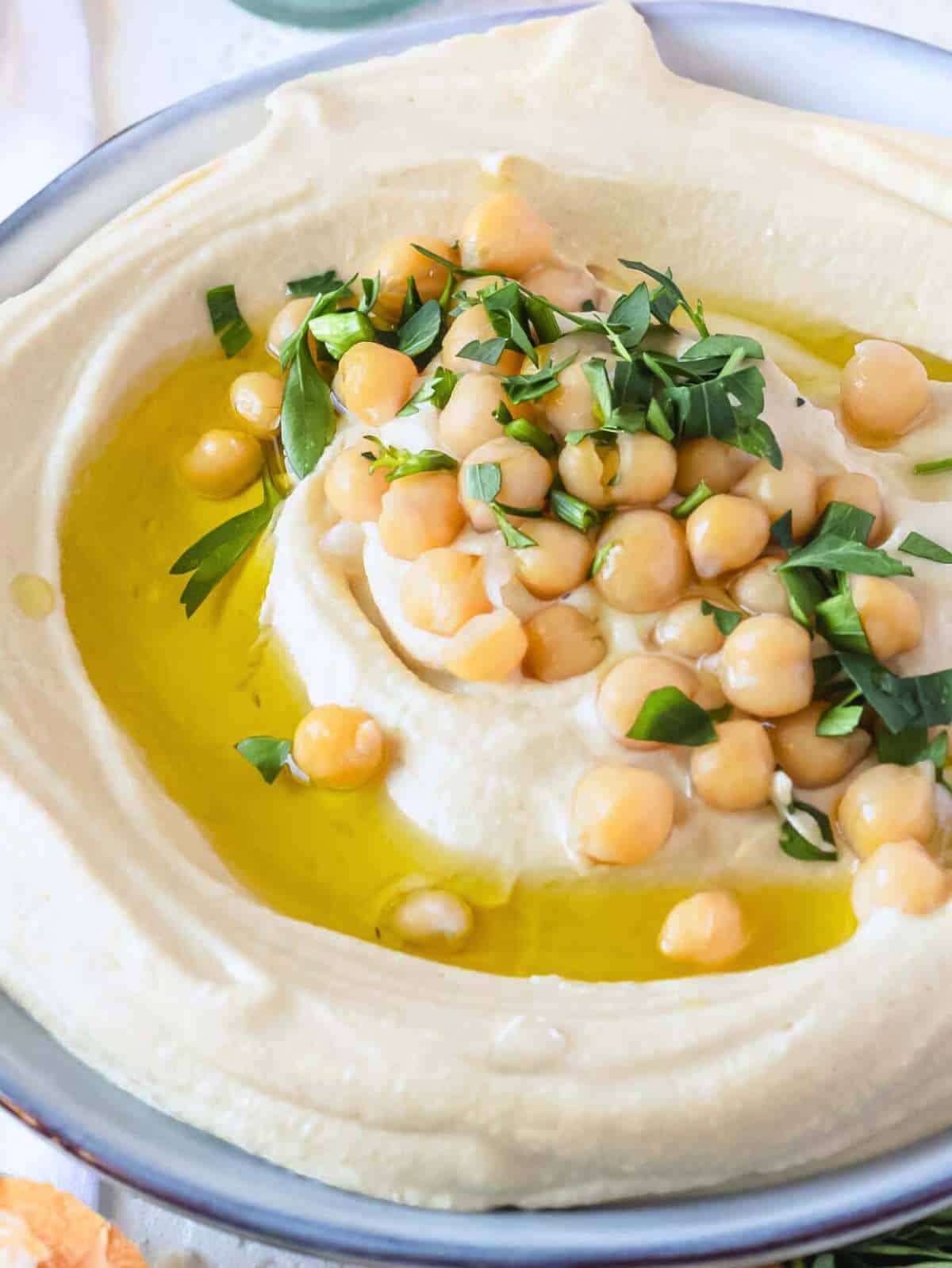
How a Tiny Deli in Berlin Taught Us the Secret to Perfect Hummus
This hummus recipe is the result of years of trials in our kitchen, pages of notes from cookbooks, and visits to incredible hummus restaurants.
Back when Louise and I were living in Berlin for work, we discovered a little deli in Prenzlauer Berg called Balabait, run by a kind Lebanese chef with a gift for making unforgettable hummus and masabacha.
It was the creamiest we’d ever had—so smooth and flavorful, it almost felt whipped. Curious, we asked him his secret. “Use the smallest chickpeas you can find,” he said, “boiled until they almost fall apart.” Then he showed us his tahini: silky, pourable, made from hulled sesame seeds—nothing like the thick, gritty stuff we’d been using.
That moment shaped how we make hummus to this day. And every time we do, it brings us right back to that tiny deli on a quiet Berlin street.
We hope that this recipe brings as much joy to your table as it has to ours ❤️.
Ingredients
Find complete ingredient list, quantities, and substitutions in the recipe box at the bottom of the page.
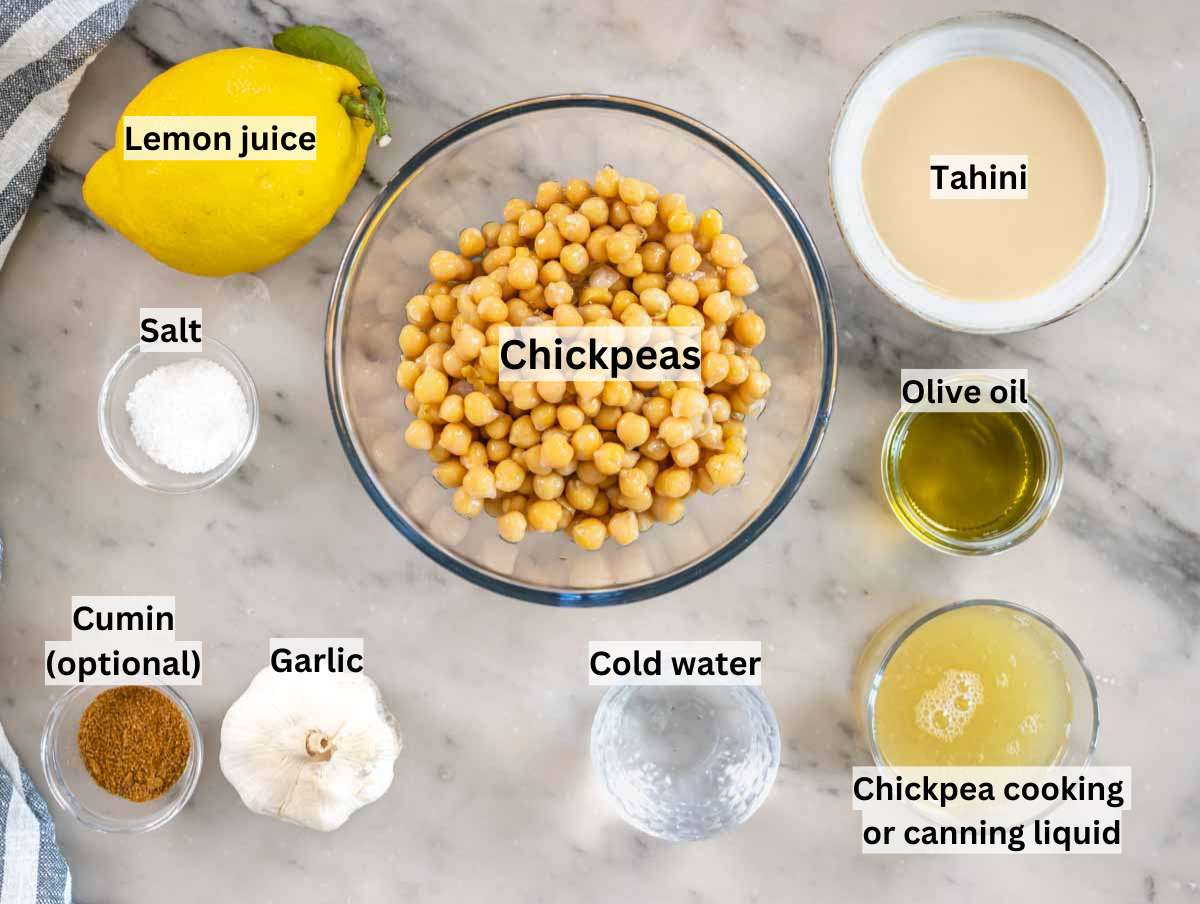
- Dried chickpeas: Use the smallest ones you can find and soak them for 24 hours and boil until slightly overcooked and ultra-tender. Here’s our guide on how to cook chickpeas. Substitute canned chickpeas, but if they are hard it’s best to boil them for 15 – 20 minutes until tender.
- Baking soda: Add to the cooking water to soften the chickpeas until they’re almost mushy.
- Aquafaba (cooking water or water in a can of chickpeas): Reserve and chill—it makes the hummus light and airy.
- Tahini: Use 100% hulled sesame seed tahini—light in color and pourable, not gritty.
- Extra virgin olive oil: Use a little in the blend and more for drizzling on top.
- Lemon juice or citric acid: Lemon juice is great for homemade; citric acid keeps it fresh longer.
- Garlic (optional): Start with half a clove.
- Italian parsley: Use flat-leaf parsley to garnish the finished hummus.
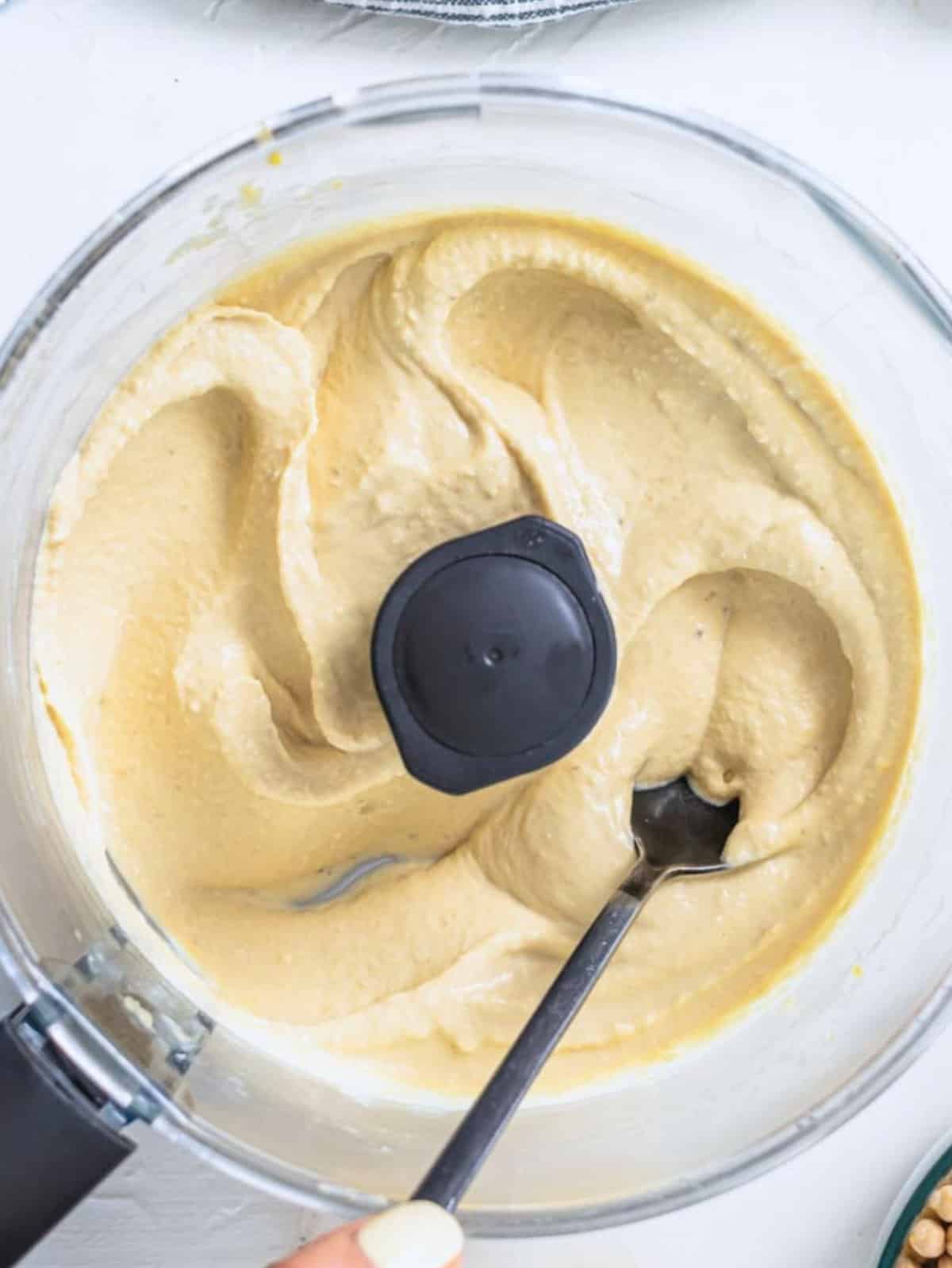
How to Make Hummus (Food Processor Method)
- Set aside 2 tablespoons of chickpeas for garnish.
- In a food processor, combine the cold cooked or canned chickpeas, cold aquafaba (cooking liquid), lemon juice, garlic (if using), and salt.
- Blend for 3 minutes, scraping down the sides as needed.
- Add the tahini, ground cumin, and half of the cold water. Blend for another 2 minutes.
- Pour in the extra virgin olive oil and the remaining water if needed. Blend for 2 more minutes, until smooth and creamy.
- Taste and adjust the salt and consistency by adding a little more water if needed.
🥄 To Serve
- Spread the hummus on a plate or in a bowl.
- Use the back of a spoon to create a well in the center.
- Drizzle with extra virgin olive oil, top with the reserved cooked chickpeas, and sprinkle with fresh flat-leaf parsley.
- Serve with warm pita bread, falafel, or fresh vegetables.
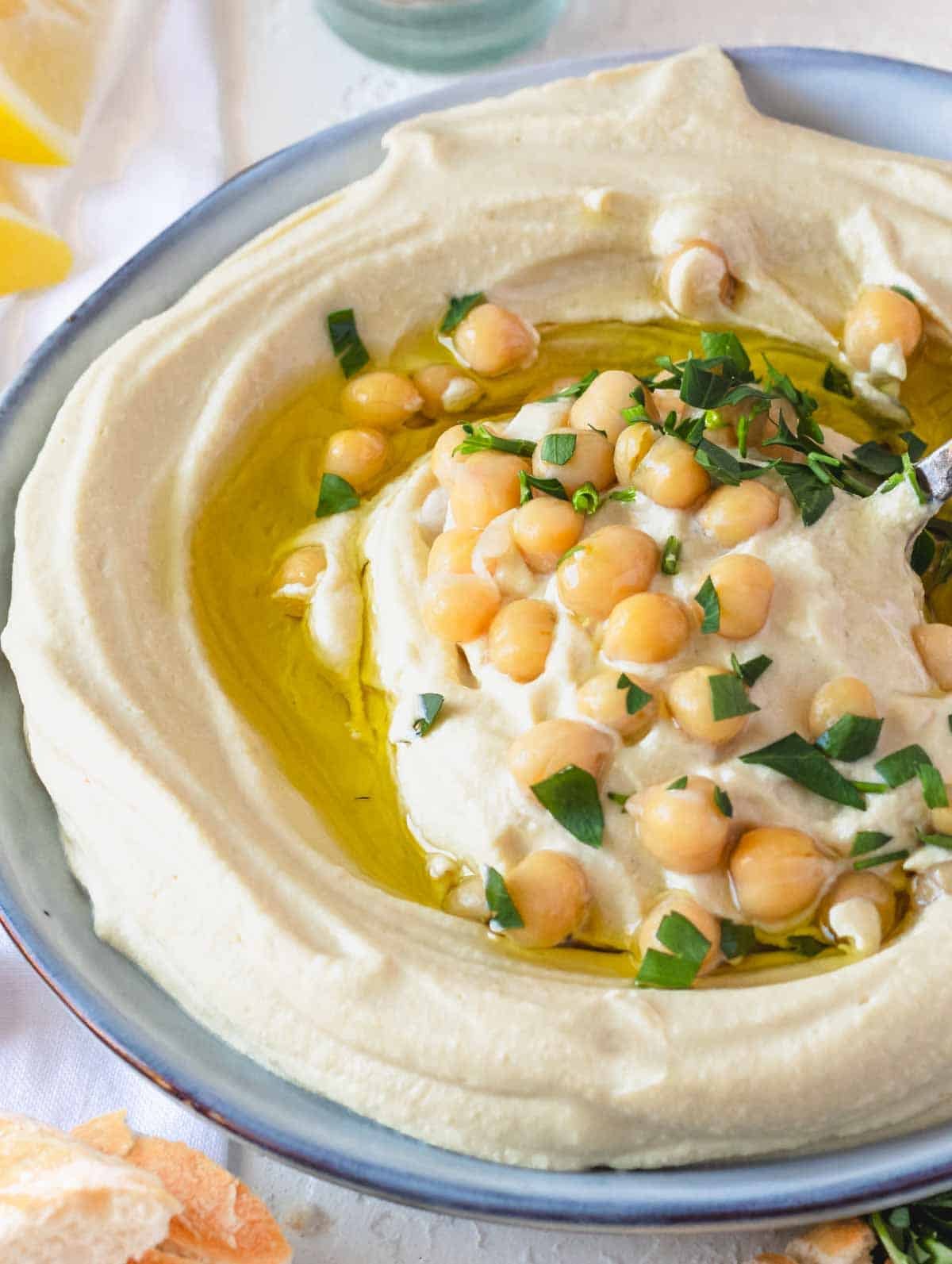
Pro Tips
General tips
- Chill your ingredients the day before, if possible.
- Add ingredients step-by-step, as shown in the recipe.
- Use small, overcooked chickpeas for the smoothest texture.
Equipment tips
- A food processor is best—it keeps ingredients cool.
- If using a blender, add 5 ice cubes and blend everything together for 2–3 minutes.
Chickpea tips
- Choose the smallest dry chickpeas for best texture.
- Boil with baking soda and overcook slightly.
- Chill chickpeas in their cooking liquid before using.
- If using canned, refrigerate the can in advance.
- Consider peeling larger chickpeas for extra smoothness.
Aquafaba tips
- Use the chickpea cooking water or liquid from the can.
- Must be cold for a light, fluffy hummus.
- Adds flavor and creaminess—don’t skip it!
Tahini tips
- Use light, pourable tahini made from hulled sesame seeds.
- Avoid dark or gritty types.
- Store in the fridge and stir before use.
Extra virgin olive oil
- Use a mild, good-quality extra virgin olive oil.
- A little goes in the hummus, the rest on top.
Cumin & Garlic
- Optional—start small.
- Their flavor grows stronger as the hummus rests.
- Hummus should taste mainly of chickpeas and tahini.
Questions
Yes—absolutely! Baking soda helps break down the chickpea skins, making them extra tender and creamy—perfect for silky-smooth hummus.
If you’re using larger chickpeas with thicker skins, you may want to remove some of the skins after cooking. Here’s how:
1. Place the cooked chickpeas in a bowl of cold water.
2. Gently rub them between your hands to loosen the skins.
3. Let the skins float to the surface and skim them off with a spoon. You don’t need to remove every skin—just enough to get a smoother texture.
We recommend using a food processor to make hummus because it’s gentler on the ingredients and keeps them cool, which helps preserve the flavor. Blenders tend to heat the mixture and reduce aeration, resulting in a denser, less vibrant spread.
If you don’t have a food processor, you can make hummus directly in a blender. Just add five ice cubes along with all the ingredients, and blend for one to two minutes, keeping an eye on the temperature.
If you follow our tips, you’ll be able to make delicious hummus from both canned and dry chickpeas.
However, we prefer making hummus from dry chickpeas because you can:
– Control the quality of the chickpeas.
– Pick the smallest chickpeas as recommended.
– Cook the chickpeas with baking soda, making them ultra-tender.
– Slightly overcook the chickpeas to get the creamiest hummus.
More Dips, Spreads, and Salads
If you tried this Hummus recipe or any other recipe on our blog, please leave a 🌟 star rating and let us know how it goes in the comments. We love hearing from you!
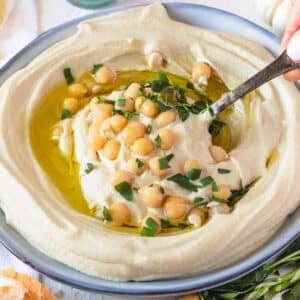
Hummus
Ingredients
- 2 cans (15 ounces each) chickpeas or 3 cups cooked chickpeas, or 1 cup / 200 grams dry chickpeas + 2 teaspoons baking soda
- ⅓ cup aquafaba the liquid in a can of chickpeas or the cooking liquid of chickpeas
- 2 tablespoons lemon juice
- ¼ cup cold water add more if necessary to reach your desired consistency
- ⅓ cup tahini from 100% hulled sesame seeds, light in color, and of pourable consistency
- 1 tablespoon olive oil extra virgin
- ½ clove garlic or more to taste
- ¾ teaspoon salt or more to taste
- ½ teaspoon ground cumin optional
- 1 tablespoon flat-leaf parsley chopped
Instructions
- Set aside 2 tablespoons of chickpeas for garnish.In a food processor, combine 2 cans (15 ounces each) chickpeas (drained), ⅓ cup aquafaba, 2 tablespoons lemon juice, ½ clove garlic, and ¾ teaspoon salt. Blend for 3 minutes, scraping down the sides as needed.
- Add ⅓ cup tahini, ½ teaspoon ground cumin, and ¼ cup cold water. Blend for another 2 minutes.
- Pour in 1 tablespoon olive oil and some more water if needed. Blend for 2 more minutes, until smooth and creamy. Taste and adjust the salt and consistency by adding a little more water if needed.
- Spread the hummus on a plate or in a bowl. Use the back of a spoon to create a well in the center. Drizzle with olive oil, top with the reserved chickpeas, and sprinkle with 1 tablespoon flat-leaf parsley.
Notes
- Chill your ingredients the day before, if possible.
- Add ingredients step-by-step, as shown in the recipe.
- Use small, overcooked chickpeas for the smoothest texture.
- A food processor is best—it keeps ingredients cool.
- If using a blender, add 5 ice cubes and blend everything together for 2–3 minutes.
- Choose the smallest dry chickpeas for best texture.
- Boil with baking soda and overcook slightly.
- Chill chickpeas in their cooking liquid before using.
- If using canned, refrigerate the can in advance.
- Consider peeling larger chickpeas for extra smoothness.
- Use the chickpea cooking water or liquid from the can.
- Must be cold for a light, fluffy hummus.
- Adds flavor and creaminess—don’t skip it!
- Use light, pourable tahini made from hulled sesame seeds.
- Avoid dark or gritty types.
- Store in the fridge and stir before use.
- Use a mild, good-quality extra virgin olive oil.
- A little goes in the hummus, the rest on top.
- Optional—start small.
- Their flavor grows stronger as the hummus rests.
- Hummus should taste mainly of chickpeas and tahini.
Nutrition

Hi! We are Nico & Louise
We’re here to share delicious, easy, and healthy plant-based recipes (vegetarian & vegan) 🌿✨.
Welcome to our blog, we are glad you are here.

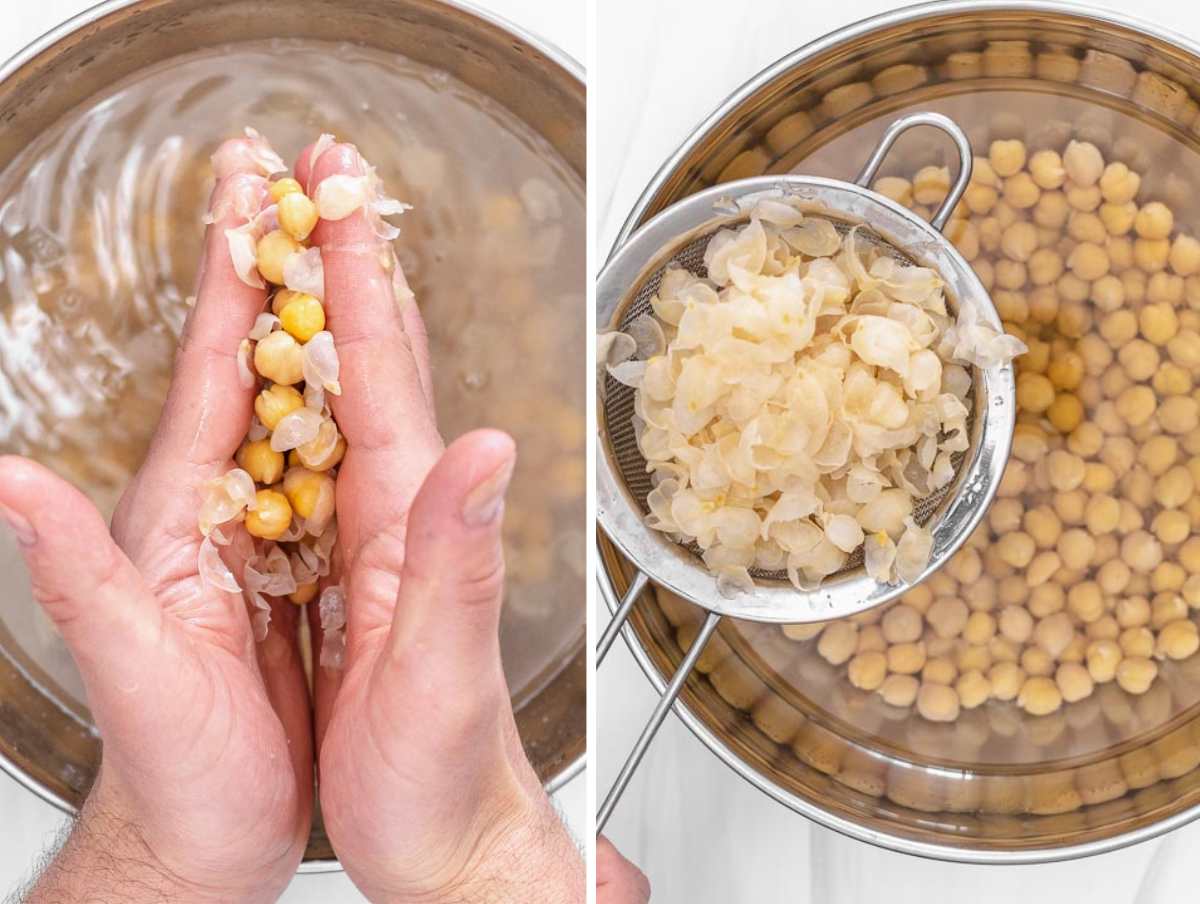
Really Really Yum! I made my Hummus in the NutriBullet ~ So easy !
I added 1c of Roasted Red Peppers & Ice Cubes instead of water .
Used all high quality ingredients as I found this makes a huge difference in taste .
I made this recipe today to take to a pot luck celebration of life. At first, my new Cuisinart would not work. Tried everything! Had to transfer to my Larger Vitamix bowl and wasn’t able to get it creamy enough. I wasn’t able to get to your site so I had to watch the video. Couldn’t get the sound to work. I kept adding water and was afraid it would be too much. The taste was delicious but the consistency was too thick. When I got home tonight, I was able to hear your video and get on your website. All in all, it took me almost an hour to make it! However, I will try to make it again after my machine is replaced, (perhaps cutting the recipe in half). I had way too much. There was a lot of food there. Thanks for the great information!
I was invited to a party tonight and I made this, it was an instant hit. So far this is my favourite hummus recipe. I’m such a big fan, keep up the good work!
Hi Guy,
That sounds great, I’m very happy you (and your friends) enjoyed the hummus. YAY!
Thank you for taking precious time to leave a comment here ☀️
Just found you!!!
Wonderful HUMMUS!
These recipes look absolutely fantastic🥰(I’m Italian/Norwegian/Swiss😋)
Please continue to tell us also WHY we have to cook this or that way…… that helps a lot!
Love you ❤️🍒🥕🥒🍋
What a wonderful mix of nationalities, Caroline!
Thank you for your kind words, so happy that you enjoyed this hummus. YAY 🎉
All the best, Louise
I will never buy hummus again. So creamy and delicious. Thank you!